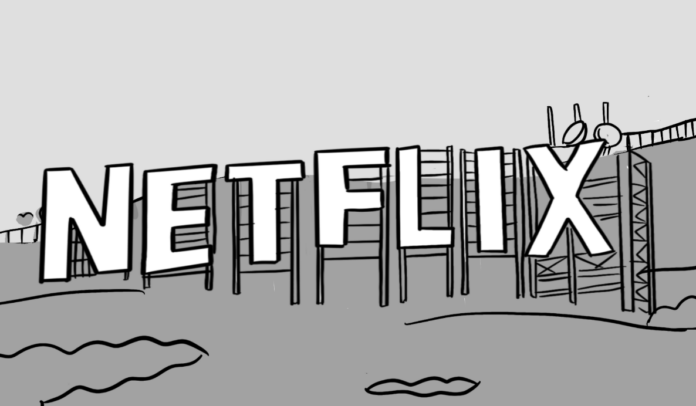The Netflix Effect
By Scott Galloway, No Malice/No Mercy, @profgalloway
Despite receiving scant coverage, the biggest business stories last week were Netflix and Meta’s quarterly earnings. The numbers were striking: NFLX profits hit $1.6 billion (up 20% from a year earlier) and the platform added 9 million new subscribers. Meanwhile, the company is raising prices. Over at Meta, revenue increased 24% and costs declined 7%, resulting in a doubling in profits. For this post though, I’ll focus on Netflix, as its management has better hair, and they’re not mendacious fucks.
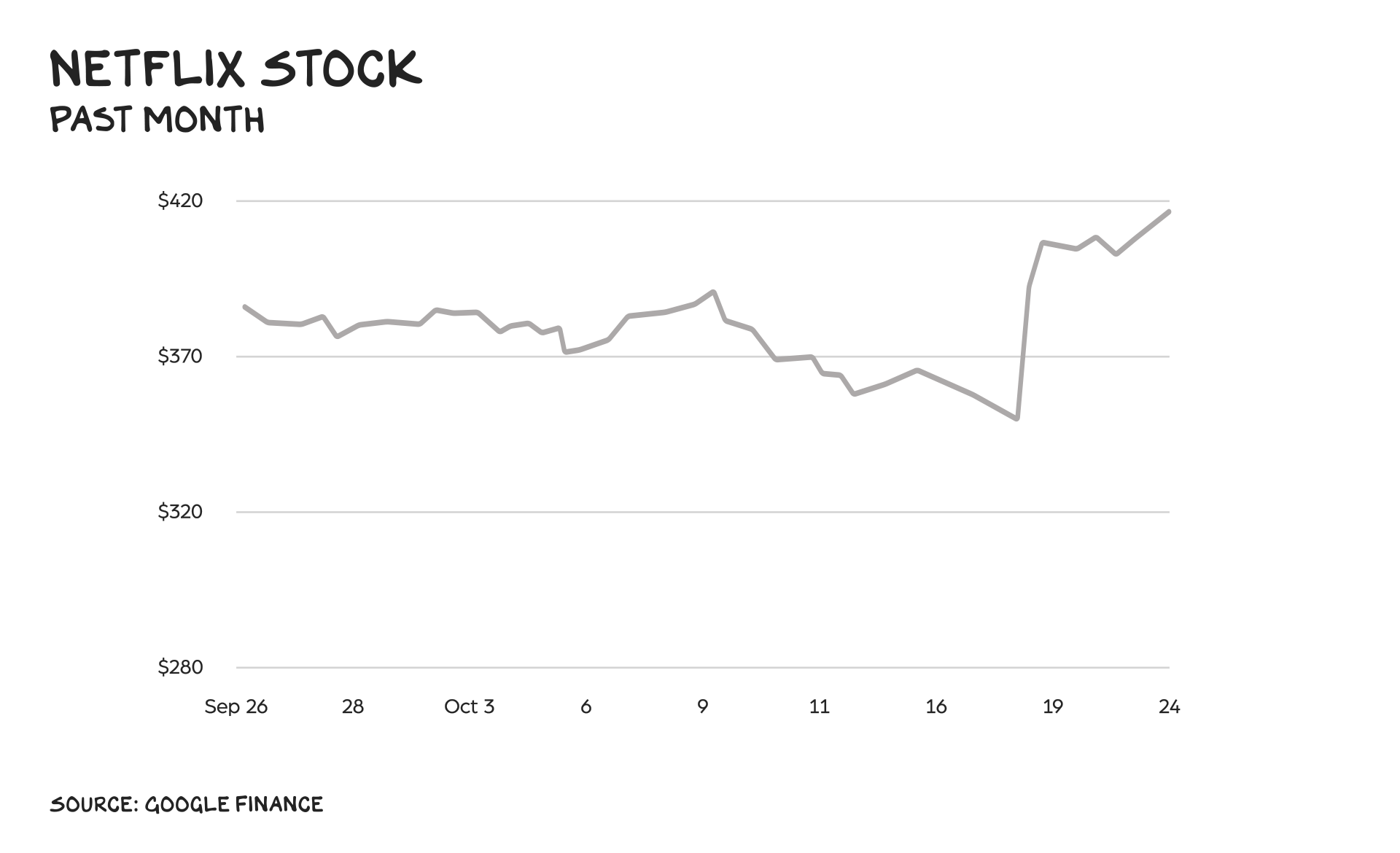
Rewind
A year ago, Netflix was losing 1 million subscribers per quarter and had shed 75% of its market cap. It was the worst performing stock in the S&P 500. Fast-forward one circumnavigation of the Sun, and Wall Street is “gushing” over its “beautiful” results while the rest of the industry flounders.
However, rebounds are not new for Netflix. Since it delivered DVDs in envelopes, the company has defied the odds. Think about it: a DVD-by-mail company turned internet platform turned Hollywood giant that would eventually join the same power acronym as Apple, Amazon, and Google. We’ve discussed entertainment’s woes at length this year, but Netflix has replaced Disney, Discovery, and Paramount on the content Iron Throne and boasts a market cap equal to all three combined.
Told You So
Five months ago I predicted the writers’ strike would do more to help Netflix than harm it. My thesis: The strike would “force” a universal reduction in spending, while actually increasing the relative value of Netflix to consumers. The streamer was able to cut costs without materially affecting the user experience, as it already had a content library as deep as the Mariana Trench. Also, it helps to not be cable, because unlike news, late-night, and sitcoms, Ozark and Bridgerton aren’t perishable.
In addition to a 20% profit bump, the company is expected to generate $6.5 billion in free cash flow this year. That’s up from $1.6 billion in 2022. Meanwhile, revenue is also up, but only slightly (8%). Which means the multibillion-dollar windfall is a direct consequence of lower costs — that is, not having to spend $20 million per episode on The Witcher. Analysts are even cautioning against too much optimism, as the “resolution of the writers’ strike will bring higher costs” and thus depress profits. Put another way, investors don’t want the strikes to end. Would we be surprised if we found out the folks running the WGA/SAG-Aftra were covert assets working for the streaming giant? NETspionage if you will (couldn’t resist).
Anyway, Netflix’s strength in the face of the work stoppage was both a function of the strikers’ lack of long-term strategy and Netflix’s abundance of it. Over the past two decades the company has employed several simple but important business strategies that have endured. Let’s review them.
Diversify
I asked ProfG.AI to explain the value of diversification. Its answer: “Diversification is the kevlar that protects you from fatal financial injuries. It’s a defensive strategy that limits your downside, even if it limits your upside.” I’d hate to hang with this guy, but he isn’t wrong.
Netflix has invested heavily in diversification, in the form of international content. The company is shifting spending away from Hollywood and increasing investment in local-language productions. In the past two years, spending in Asia has increased to $2 billion and European investment has doubled. More than half of Netflix’s scripted titles are being produced abroad. Compare that to Warner Bros. Discovery (a third) and Paramount (a quarter). The effect has been protection against supply chain interruptions (i.e. content shortages), because while American actors and writers went on strike and TV series orders declined 25%, the foreign production gears kept grinding.
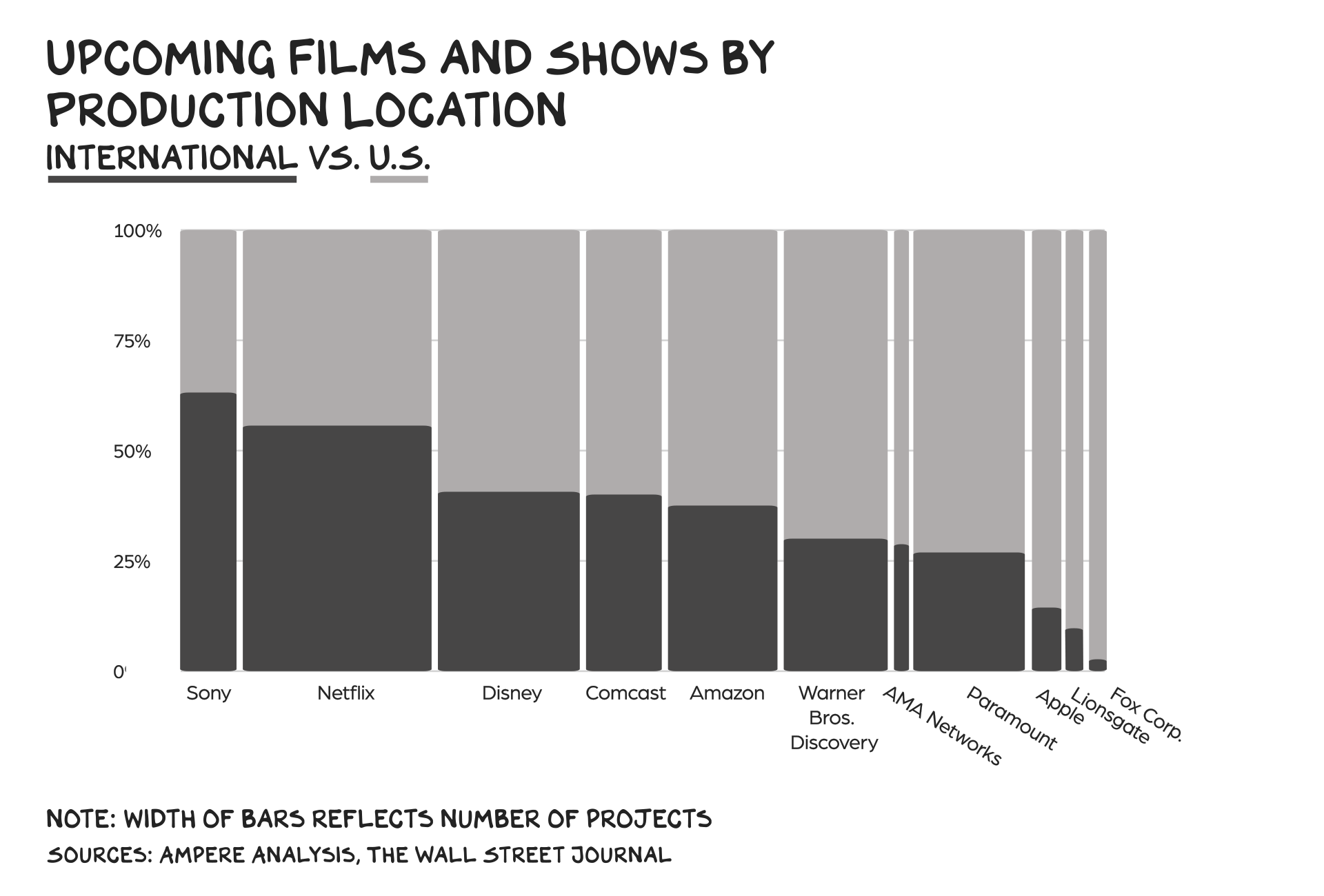
In addition, Netflix has diversified its library with a mix of original and licensed content. One of its more creative moves this year was approaching NBCUniversal to buy the rights to Suits. After debuting on Netflix this summer, the 2011 legal drama (featuring the divorcée who saved a prince from the horrors of Buckingham Palace) performed better than any original Netflix show this year. Scratch that — better than any show, period. Suits was the most streamed show across all platforms for three straight months this year, hitting the record for most-ever weeks at No. 1. This is the Netflix Effect in action: Take a solid series, reheat it, and make it the most consumed content on the planet.
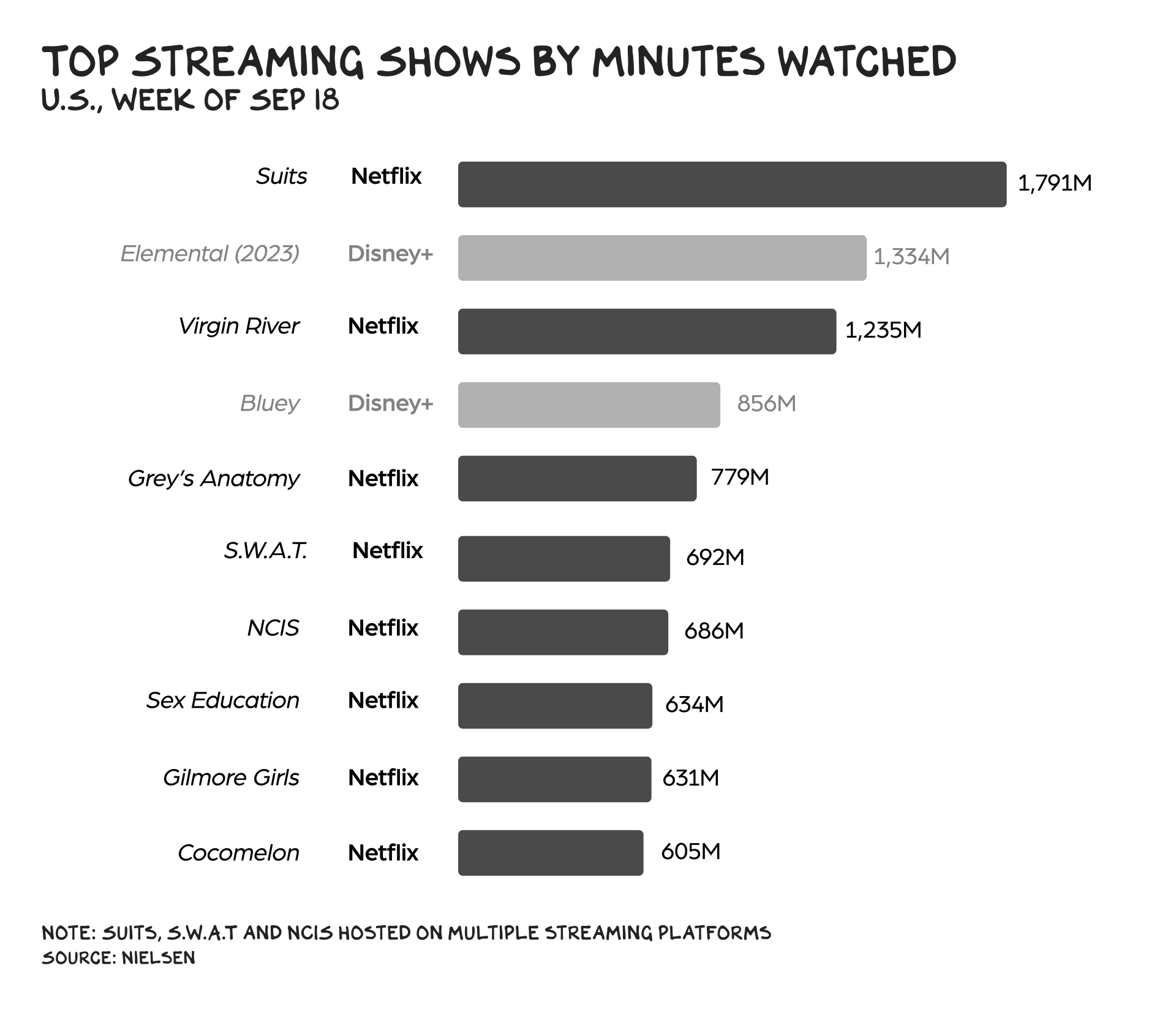
Adapt or Die
The species that survive aren’t the strongest or fastest but the most adaptable. As we’ve discussed before, the most valuable companies in the world all have one thing in common: They build a thick layer of innovation on top of investments made by the premier VC in history, the U.S. government. Apple used Darpa’s GPS to build the iPhone. Facebook built an app on top of a government-funded hosting service called the Internet. And Netflix, like Amazon, leveraged the nation’s largest content distribution platform — the U.S. postal system — to send DVDs by mail.
Mailing DVDs sounds dense now, but it was a great business. The company launched in 1997, went public in 2002, and reached a billion dollars in revenue in 2006 by addressing a pain point: that IED in your kitchen drawer, the VHS of Turner & Hooch you forgot to return. The company’s leadership could have settled and backed away from the massive investment required to pivot to streaming. But CEO Reed Hastings recognized another multibillion-dollar investment in broadband would soon render DVDs obsolete. “Don’t be afraid to change the model,” Hastings said, and in 2007, Netflix introduced streaming to the world.
Streaming was not the company’s only bold pivot. In 2011, despite its reputation as a “platform,” Netflix decided to foray into original content. At the time, it seemed absurd. The company was going up against Universal, Paramount, Warner Bros., Disney, and Sony — Hollywood titans known in the industry as the Big Five. Still, Netflix dove in headfirst, spending $2 billion on content in Year One. One of its first original series, House of Cards, went on to earn 33 Emmy and 8 Golden Globe nominations.
Opportunities vs. Problems
Peter Drucker said invest in your opportunities, not your problems. Few have done this better than Netflix. For a long time, the company’s obstacle was plain to see: It was burning hundreds of millions in cash every year. But Netflix knew brute force was its strength. Specifically, it recognized the market viewed it as a tech company, so it did what other media companies couldn’t: Massively invest, lose money, and grow.
In 2015, Netflix registered negative $840 million in free cash flow. By 2017, that number was negative $2 billion; two years later, negative $3 billion. Fearless spending was its differentiator. Capital as a weapon, if you will — specifically, cheap capital. Original content spending at Netflix grew faster than at any other streaming service, and by 2021 the company was investing $18 billion on content per annum, with free cash flow still in the red. Meanwhile, the legacy media players were beholden to a different investor base that wouldn’t tolerate the losses needed to go toe-to-toe with the streaming platform.
Netflix is now firmly profitable in all aspects of the business. It is the only entertainment company with a profitable DTC streaming business, and the legacy players are playing catch up.
Name Your Price
Netflix’s decision to increase subscription prices this quarter reflects the strength of the platform. It has reached utility status. There are 140 million households across the U.S. and Canada, and 77 million Netflix accounts. Consumers no longer consider the cost benefit of a subscription. The question isn’t if you subscribe to Netflix, but rather, what other platforms you decide to accessorize it with.
The premium plan is now $22.99 per month, up 15%. Meanwhile, the standard ad tier remains $6.99. Netflix has correctly adjusted for the most fundamental economic trend in America, income inequality. It has adopted a means-based pricing strategy that retains low-income users while squeezing more from upper-income households. Plus, research has found that introducing lower-quality products actually increases sales of your higher-margin premium products. I was skeptical of Netflix advertising at first, but it may ultimately drive more users to the premium product.
Threats
I’m tempted to say the only thing that can stand in the way of Netflix is Netflix. But that’s not true — it’s TikTok and YouTube.
We’ve discussed TikTok’s ascent before. The Chinese juggernaut is stealing eyeballs (especially young ones) from the streamers and generating $25 billion in quarterly revenue in the process. BTW, that number is up 34% from last year.
Less discussed, however, is the threat of YouTube. Netflix gave it a casual mention in its shareholder letter, but the implication was so relaxed as to be tense. “Our share of TV screen time in the U.S.,” the letter read, “is greater than any streamer other than YouTube.” This was meant as a not-so-humble brag. It isn’t. YouTube is the most popular TV streaming service, and that doesn’t account for the minutes it gets on laptops and mobile phones. I assume (hope) management recognizes this is a problem.
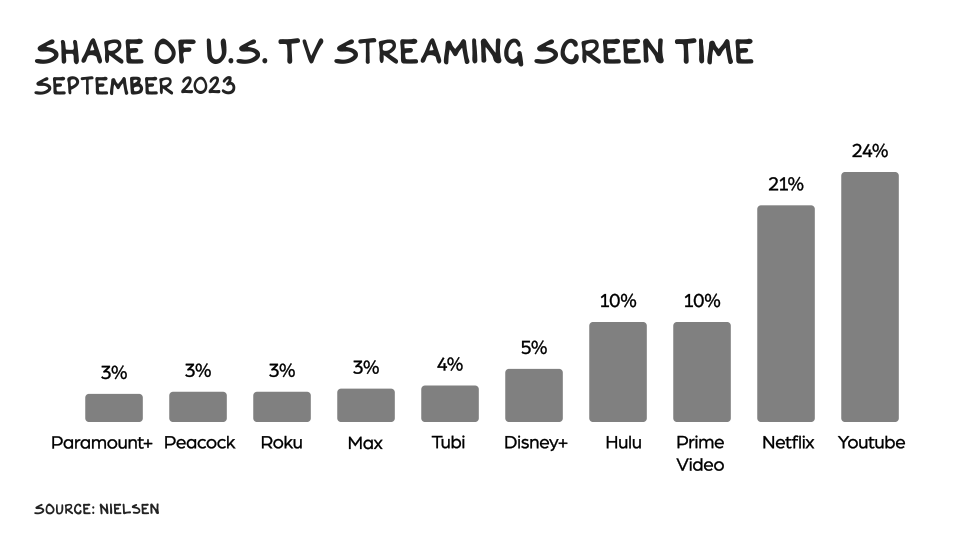
Bill Maher
I’m going on Bill Maher tonight. It’s my fourth time, and when they introduce the panel a wave of fear always envelops me that this will be one of the times I have a panic attack. (I get them 0.7% of the times I speak.) It’s important to me, as I respect Bill and his team, and my 93-year-old father only watches two things: Maple Leafs hockey and Bill Maher. He recently called me to announce I was on, as if it was news to me. He’s struggling.
I’m sitting in my room, on the 60th floor of the Wynn hotel, writing this. Every year for the past 35, my three closest friends and I have come to Vegas for my birthday. The trip’s changed: We now spend more time in the spa and less in the casino, but the company remains the same. I look out my window and see Summerlin, where I lived for seven months 20 years ago. My mom, battling cancer for the third and final time, asked to die at home. I moved in with her. She had raised me alone, on a secretary’s salary, and it was the right thing to do. It wasn’t much of a sacrifice for me, as I had no real relationship and no real career, and found the experience rewarding. During the day I’d manage her health care and we’d watch Everybody Loves Raymond and Jeopardy together. At night, I’d venture downtown where I’d party with a friend, a young guy who’d moved from Houston to open a cigar bar, and strippers. One night, I met him at the Rio hotel and he gave me a “healing candle” for my mom, whose breast cancer had metastasized to her stomach and was terminal. A candle. People are strange, and wonderful.
Today’s appearance on Maher will happen, but not really. Whenever anything really great happens to me, I instinctively think to call my mom and bask in our collective victory … we made it. Her response would cement it, make it real. These days, wonderful occurrences sometimes don’t feel as if they’ve happened, as she’s not there. I am 58 and, two decades later, still not over the death of my mother. And that’s OK. I hope my boys feel the same way about me when I’m gone.
Life is so rich,
![]()
P.S. Our Prof G Markets podcast is hitting new records. Tune in every Monday for our fresh take on what’s moving the capital markets.
P.P.S. Ex-Netflix VP for Product Gibson Biddle is teaching the Product Strategy Sprint starting Nov. 6. Watch the first lesson on his DHM (delightful, hard-to-copy, margin-enhancing) model for free.


